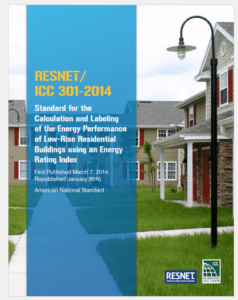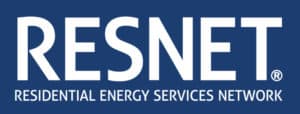Raising the Bar for Innovative Building
How Cadmus helped RESNET develop energy code changes that benefit builders, officials, consumers, the market, and the environment
The Residential Energy Services Network, or RESNET, is a national standards-making body for building energy efficiency rating and certification systems in the United States. RESNET’s standards are recognized by a number of industry organizations and government bodies, including builders, contractors, and federal government agencies, such as the Internal Revenue Service, U.S. Environmental Protection Agency, and U.S. Department of Energy.
Challenge
Innovation is fundamental to improving energy efficiency in buildings. Over the past decade, new technologies and advanced systems integration have transformed the way the residential building industry meets energy code requirements. Despite the progression of equipment and technology, until recently, the residential energy code lacked a compliance option that encouraged innovation.
In 2015, the International Code Council (ICC) introduced the Energy Rating Index (ERI) into the International Energy Conservation Code (IECC). The ERI was intended to provide a compliance option that benefits builders, code officials, consumers, the market, and the environment alike by:
- Encouraging innovation and flexibility in design and construction
- Increasing building performance, quality assurance, home resale value, and job opportunities
- Reducing utility bills and decreasing emissions
However, the addition of the ERI into the energy code was just the beginning of the solution. The industry needed education on the benefits of the ERI, how to market it to consumers, and how to implement an energy rating in current practices. Furthermore, the ERI in the 2015 IECC lacked language to ensure uniformity and consistency in practice. RESNET engaged Cadmus consultants to help develop the code language and lead efforts to educate members of the residential building community on its benefits and implementation.
Cadmus’ codes and standards team has been instrumental in the success of the ERI from conception to practice.
Solution

Through its vast code development experience, expertise of the energy code, and empowering relationships with leading market actors, Cadmus was uniquely situated to assist RESNET with ensuring the IECC could provide clear and consistent methodologies for determining the ERI of a home.
In 2013, a Cadmus consultant collaborated with the Institute for Market Transformation, Natural Resources Defense Council, Leading Builders of America, and RESNET to develop and propose a new section for the 2015 IECC, then in development. The change introduced an innovative compliance path that gave builders the option of meeting a target ERI score through a wide range of performance options. The code change was adopted into the 2015 IECC as Section R406: Energy Rating Index Compliance Alternative. The ERI performance path of the 2015 IECC allows a state or jurisdiction adopting the IECC to decide which qualifying ERI option it will use.
RESNET’s Home Energy Rating System (HERS) index—the nationally recognized system for inspecting and calculating the energy performance of a home—is currently the only ERI-compliant rating method on the market. Cadmus staff developed widely distributed training material and fact sheets to support education and implementation of the ERI compliance option and inform industry users of RESNET’s unique ability to determine an ERI score through the HERS index.
In 2016, Cadmus again worked with RESNET to develop and support a code change to the 2018 IECC that would expand on the ERI compliance alternative by including ANSI/RESNET/ICC 301-2014 (Standard 301). Standard 301 is a nationally recognized standard that provides a uniform and consistent methodology for evaluating and labeling the energy performance of homes. Standard 301 synthesizes and condenses several sections from the 2015 IECC to simplify the code. Prior to the 2018 IECC code change hearing, Cadmus developed educational and support material for Standard 301.
As with the ERI, Cadmus supported Standard 301 through the ICC IECC code development process; the Standard will be referenced in future versions of the IECC. Standard 301 simplifies code language in the 2018 IECC by removing duplicate provisions and ensures that the ERI approach is deployed using a standardized process from a consensus document.
Results
Since the adoption of the ERI compliance alternative into the 2015 IECC, and through efforts made to educate, promulgate, and implement the ERI:
- As of May 2017, the 2015 IECC (including the ERI compliance path) had been adopted and implemented by 11 states, with several other states in the process of reviewing the code for adoption.
- Over 150 local jurisdictions have adopted an ERI-based compliance path.
- More than 206,000 homes were rated in 2016, the highest number of HERS-rated homes in a single year.
- Approximately 38 percent of all new homes built in 2015 were rated using the RESNET HERS Index.
- As RESNET Executive Director Steve Baden has stated, “homebuilders are increasingly seeing energy efficiency as a major selling point for buying a new home.” To show a reliable indicator of their facilities’ energy efficiency, builders are requesting an ERI score to use in marketing the project in multiple listing services (MLS). More than 15 states currently allow the inclusion of ERI scores for compliance with the energy code.
“Cadmus’ professionalism and knowledge of energy efficiency codes and standards are second to none. Their experienced team has really helped RESNET facilitate broad acceptance of standards that make it easy for builders to achieve compliance with the energy code and for consumers to make informed decisions on their energy consumption.”
—Steve Baden, Executive Director, RESNET
Learn more about Cadmus’ support for high performance buildings and plants.
You can see the resources developed by Cadmus at the bottom of this page on RESNET’s website.
